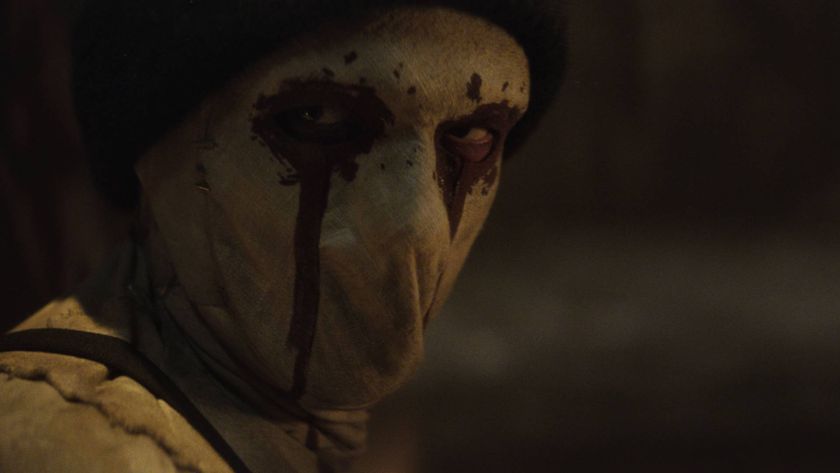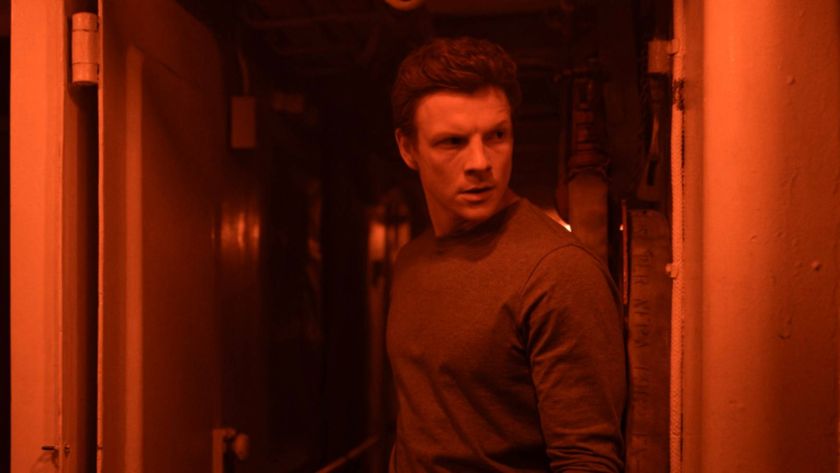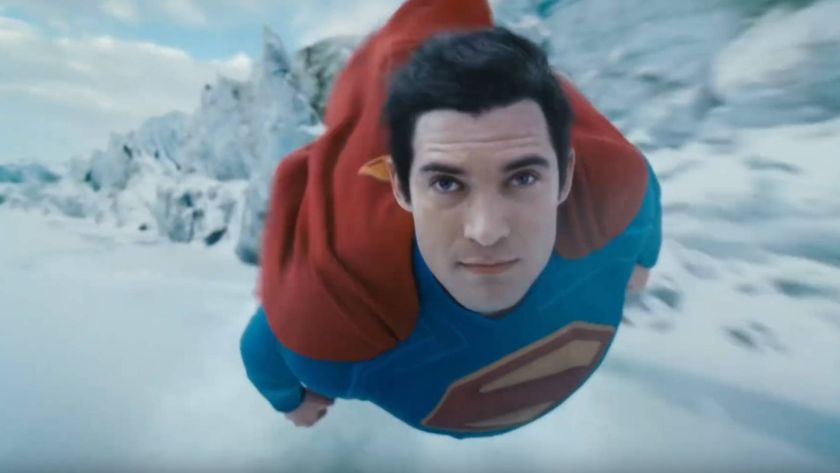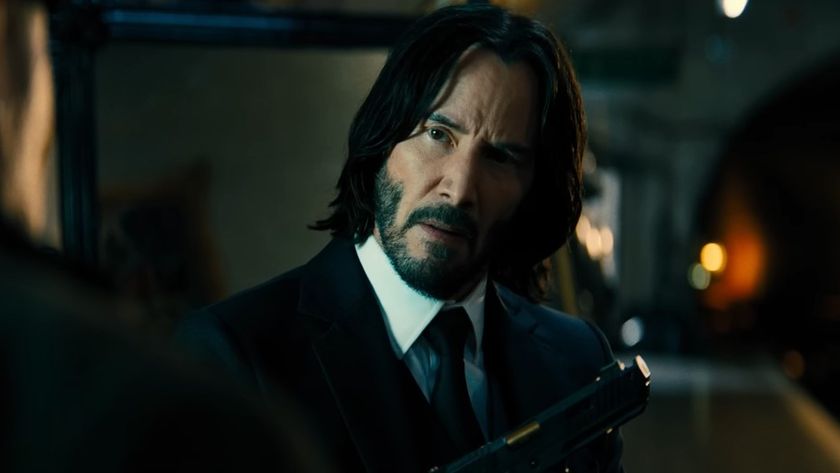Its Gone All 2001
None
10 movies that tried to emulate the ground-breaking/baffling (delete according to art-house cinema threshold) climax to 2001: A Space Odyssey
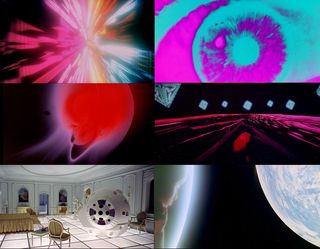
It was the ultimate trip. Or the ultimate snooze, depending on what frame of mind you’re in (or what you’ve been smoking, or how many shots of pink mountains you can stand in a film). The finale to 2001 is one of the most controversial, enigmatic and beguiling sequences in cinema history. A nine-minute version of the Doctor Who opening titles accompanied by the sound of a bee stuck in a dustbin, followed by some weird shit in a luxury hotel room with an astronaut watching himself age and climaxing with a giant foetus floating towards Earth, it has managed to provoke more discussion, argument, interpretation, contempt and admiration than six seasons of Lost .
But love it, hate it, or simply unable to know what to make of it, there’s no doubt that it’s a landmark of SF cinema. Audacious and uncompromising, it demands some kind of reaction from the viewer. And it has also been amazingly influential. Its combination of psychedelic imagery, religious allusion* and baffling concepts have often been imitated, but never quite matched.** Some SF films have just swiped elements of it, others have copied it wholesale, some have missed the point completely and one, in particular, appeared to use it as an inspiration for the last two thirds of the plot…
So, let’s take a look at the culprits… Warning: there will by necessity be plot spoilers.
* To be honest, on one level 2001 is one of the most athiestic films imaginable, but you can’t deny there are biblical allusions – the monolith as the serpent in the Garden of Eden, rebirth and resurrection, etc, etc – almost as if it’s saying the intervention of the “aliens” has been reinterpreted as religion. Erm, excuse this developing into pseud’s corner, the film has that effect on you.
** One of the great ironies of cinema history is that the sequel 2010 was a film that didn’t try to emulate its predecessor in this regard, which was probably a good idea.
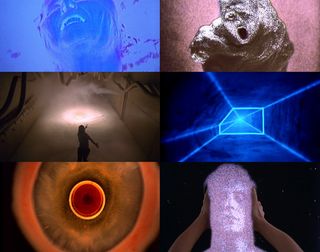
ALTERED STATES (1980)
Director: Ken Russell
Sign up to the SFX Newsletter
Get sneak previews, exclusive competitions and details of special events each month!
Religious imagery: Mild (but there’s loads elsewhere in the film)
Tunnel effect: Yes
Random lightshow: Yes
Blobs: Yes
Evolutionary allusions: Yes
Giving Ken Russell a script about a man experimenting with drugs and sensory deprivation is a bit like giving a pyromaniac some matches and the keys to a firework factory. The film is full of psychedelic dream sequences. If you want naked iguana women, goat-headed men getting crucified and giant flowers, this is the film for you. Oh, and it’s also got William Hurt turning into a caveman and running amok in a zoo. And just when you thought things couldn’t get any more ridiculous, Hurt’s final experiment turns him into a one-armed, glowing blob thing, while the lab around him becomes a milky maelstrom sucking in any pretense the script had at making sense. Cue some lava-lamp blobs, something that could be the back of your eyeball and swirling stars. Quite what’s supposed to be going on is anybody’s guess. Clearly dear old Ken doesn’t give a monkeys. The blob-monster may be barely-formed foetus because Hurt’s character wibbles on about regressing to the birth of humanity. Rather disturbingly, his girlfriend describes the experience as a consummation: “He finally got it off with God.” Eurgh, does that mean we’ve just been watching The Almighty in his first porn role?
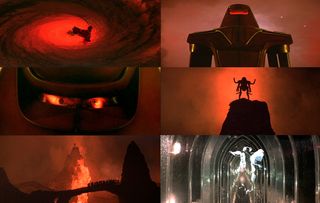
THE BLACK HOLE (1979)
Director: Gary Nelson
Religious imagery: Oh yes
Tunnel effect: Yes
Random lightshow: Yes
Blobs: No
Evolutionary allusions: No
Back in an interview in 1979, Gary Nelson admitted that even while he was making the film, he and his writers didn’t really know how it was going to end. Watching the film today, it seems that the final decision was to hand the FX crew a script with, “Do some shit here,” scribbled on it. So, the heroes are sucked into the film’s eponymous ex-star, where they watch the film’s villain and his hench-robot floating about, before they eventually embrace and become one, the creator peering out through the eyes of his creation. We’re sure it’s all very Freudian or Brechtian. Ego battling with superego. Creator raped by creation. But come on, this is DISNEY! We’ve just been watching a film about cute robots versus evil cyborgs with lasers and stuff. It’s like Dumbo ending with in an orgy. Then again, it was the first Disney movie to get a PG rating…
Anyway back to the weirdness, and now robot Max is standing atop a mountain in what is presumably Hell, with tongues of fire lapping up at him, and shadowy denizens mooching in the shadows. All it needs is some music by Offenbach and we’d have the great lost segment from Fantasia . And finally, we zoom through some ecclesiastical arches accompanied by an ethereal angel, until we pop out of the other end of the black hole. The whole sequence is clearly desperately trying to evoke the metaphysical splendour of the 2001 stargate sequence, but the imagery is so ponderously unsubtle that it actually ends up looking plain silly.
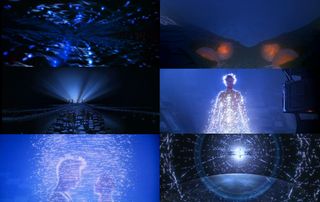
STAR TREK: THE MOTION PICTURE (1979)
Director: Robert Wise
Religious imagery: Yes
Tunnel effect: Yes
Random lightshow: Yes
Blobs: A few
Evolutionary allusions: Yes
The first Trek movie was clearly in love with 2001 . It wanted to make love to it and have its babies. So much so, that pretty much became the plot. The Motion Picture doesn’t have one particular 2001 -style sequence; it pretty much manages to stretch the stargate sequence across two thirds of its running time. When the Enterprise goes to intercept a massive space cloud that’s approaching and threatening to destroy Earth, it’s a cue for a mindnumbing number of shots of the Trek crew looking on in awed wonder (or in Shatner’s case, confusion) at the starship’s viewscreen showing, erm, blue, fuzzy stuff. On and on it comes, relentlessly, as the Enterprise journeys into the heart of the thing. It’s often bewildering rather than mindblowing as the internal geography of the thing appears to have no logic, but there are some impressive sights if you can keep your concentration from wandering.
Then Kirk and co discover the secret of the cloud. At its centre is an old space probe sent from Earth which has discovered sentience on some robot planet or other and now wants to meet its maker. It’s a bit miffed to find out, then, that its creators were, eurgh, organic. But hey ho, it still fancies a shag and next thing you know it's cross pollinating with bloke who’s new to the crew for this film and creating a new hybrid lifeform with a nice theatrical touch of religious imagery.
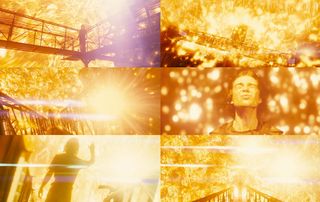
SUNSHINE (2007)
Director: Danny Boyle
Religious imagery: Yes (look at the shape of that gantry Capa is standing on)
Tunnel effect: No
Random lightshow: Yes
Blobs: Sorta
Evolutionary allusions: No
The shortest 2001 moment in this list, but a moment that has a similar impact on the audience – intriguing some, simply pissing off others, but definitely demanding some kind of reaction. At the end of a film that has largely been fairly realistic and rigorous with its science, Capa, the last sane man aboard spaceship (well, what’s left of it) heading towards the sun, sets off a massive nuclear explosion to re-ignite the dying star. Thing is, he’s standing inside the multi-storey bomb as he ignites it, and a second before the explosion engulfs him, the wall of flame freezes mere inches from his face. He smiles, seemingly in some kind of rapture, and reaches out to touch the frozen explosion, almost as if he’s waving at it, welcoming it.
As director Danny Boyle says: “For me this image was always that he was sandwiched between science’s power – the most terrifying and awesome thing we’d ever invented, this nuclear bomb – and, if you like, nature’s power, some people call it God’s power. And for a moment – for a billionth of a second – he’s sandwiched between these two forces. And for me he sees something, not necessarily God… he sees something beyond the rational, really. Beyond words, beyond imagination. I like the idea that there are things beyond what you can talk about. We inherited that really from 2001 . Where you try to do something at the end of a film that’s purely visual, and let people’s own predilections, and their own experiences, and their own imagination work on the film as much as possible.”
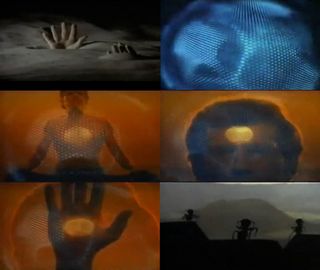
PHASE IV (1974)
Director: Saul Bass
Religious imagery: Yes
Tunnel effect: No
Random lightshow: Yes
Blobs: No
Evolutionary allusions: Yes
Phase IV is a largely forgotten early ’70s curiosity directed by the man who created the title sequences for a number of Hitchcock films ( Vertigo , North By Northwest , Psycho ) as well as West Side Story and many other classics. It’s about ants taking over the world, but about as far away from Them! or other ’50s giant bug movies as you could imagine. This is insectoid invasion is done 2001 -style. Lots of very sombre-looking scientists with half a personality but plenty of frowns between them talk very seriously about the threat posed by intelligent ants. It’s slow, it’s methodical and it’s full of very striking images. It’s also more than a tad dull. Right at the end the ants bond with a female scientist so that they can communicate their intentions to another scientist. But instead of sitting down for a good old chinwag (“Sorry mate, but six legs good, two legs bad is the future!”) this chat seems to involve lots of spinning, a pulsating blue domed thingy, a bit of sun worship, some groovy camerawork and lots of crossfading. The original ending went even more with a montage of images of the Earth under ant rule. Sadly this was cut, and we’re left with something that looks like MTV would have broadcast if it had been around in the ’60s.
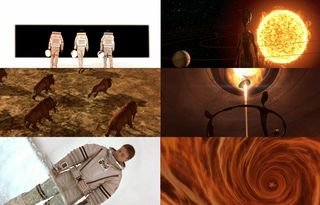
MISSION TO MARS (2000)
Director: Brian De Palma
Religious imagery: Yes
Tunnel effect: Yes
Random lightshow: Yes
Blobs: Yes
Evolutionary allusions: Yes
Mission To Mars is a Seth Brundle version of 2001 . It’s like 2001 has stepped into a teleport pod not realising that a Sunday night ITV drama with “Heart” in the title had slipped into the pod as well. The resulting teleport splices their genes together. The result is a film that’s like 2001 trying to appeal to a soap-watching audience (or Defying Gravity , which is pretty much the same thing).
It kinda goes through the 2001 motions. There’s a space mission that tries to be as scientifically accurate as possible. There’s a mysterious alien artefact found on Mars. There’s an alien race that helped manipulate life on Earth. There are massive structures. Clinically white sets. All the elements are there. But the banal human storylines and cheesy plot devices make the film a chore to watch, and despite a big budget, there’s an almost total absence of sense of wonder. This extends to the climax, which clearly aims to be a BIG! SIGNIFICANT! MEANINGFUL! revelation of 2001 proportions, but ends up with silly CG aliens presenting their less impressive version of Fatboy Slim’s “Right Here, Right Now” video.
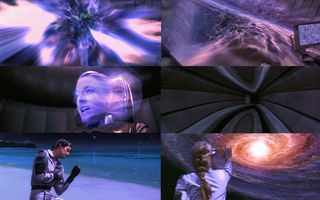
Contact (1997)
Director: Robert Zemeckis
Religious imagery: No
Tunnel effect: Oh yes
Random lightshow: Yes
Blobs: No
Evolutionary allusions: Sorta
Contact ’s big sequence is a bit like a high octane version of 2001 ’s stargate with a commentary. Y’see, using instructions sent by aliens (it’s a bit like shopping at Ikea, only the manual makes more sense), scientist Ellie Arroway (Jodie Foster) constructs a device that leapfrogs her across the universe and meet the craft’s creators. Visually the scene is very reminiscent of 2001 … if you played the stargate sequence at about 100 times normal speed. The other major difference is that director Robert Zemeckis doesn’t do “enigmatic” – the idea of giving the audience something they might have to interpret is alien to him. So instead we have Ellie nattering throughout, theorising about what’s going on. Even when she ends up on a beach where she can touch a galaxy hanging in the sky (lovely image) the aliens explain that this is just a place they’ve created to make her happy and comfortable. Contact has a lot of great points, but it's all too neatly packaged and easily digestible to ever have the impact of 2001 .
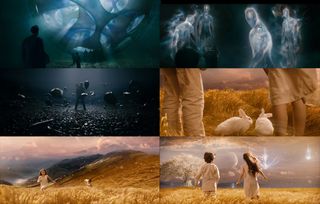
KNOWING (2009)
Director: Alex Proyas
Religious imagery: Yes
Tunnel effect: No
Random lightshow: Yes
Blobs: Do floating rocks and that odd grass on the alien planet count?
Evolutionary allusions: No
Oh dear. Knowing could really have done without its 2001 -inspired ending. The thing is, the first two thirds of the film is a clever-constructed SF mystery thriller (with one of the best ever cinema plane crashes ever, to boot). You really are desperate to know how a note from the past can predict major disaster in the present. It's chilling, intriguing and engrossing. And then comes the big revelation – it's all a big scheme by a bunch of angel-like aliens to select two children to rescue before the Earth blows up. The kids are then taken of to a planet that look suspiciously like the garden of Eden.
Aside from the fact that whole Adam and Eve thing is a cheesy SF cliché, the ending seems more like a get-out clause than awesome, mindblowing piece of conceptual cinema. It’s not a clever enough solution to the initial mystery (and it actually doesn’t make any sense either, but that’s for another article). It's like an episode of Diagnosis: Murder in which the killer turns out to be Kim Il-Sung.
It is very pretty, though, and the alien spaceship is a wonderful piece of design.
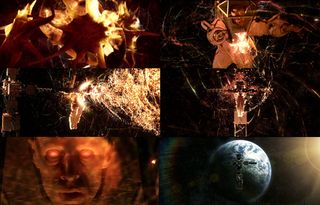
DANTE 01 (2008)
Director: Marc Caro
Religious imagery: Yes, yes, yes, yes, yes, yes, yes
Tunnel effect: Yes
Random lightshow: Yes
Blobs: Yes
Evolutionary allusions: Erm, we think so…
Yes, that’s Marc Caro as in “Jeunet and Caro”, the pair of French directors who gave us such quirky classic as The City Of Lost Children and Delicatessen . They’ve long since gone their separate ways, and Jeunet has created more movie magic like Amelie and Micmacs . Caro, though, took longer to direct his first solo effort… and frankly, it really wasn’t worth the wait.
It’s an attempt to create one of those cheap, claustrophobic, edgy SF thrillers set in a confined space, in this case an orbiting prison facility. A new arrival is the survivor of a close encounter with… something never determined that has left him with the ability to resurrect dead people by removing jellyfish from their chest. Why have they got jellyfish in their chest? Not sure. We think it’s symbolic of something or other. Why not? Everything in the film is dripping with unsubtle religious symbolism, from the crucifix-shaped space station to the names (Saint Georges, Buddha). By the time resurrection guy goes on a spacewalk at the film’s climax that results in his own jellyfish putting on a spectacular lightshow, you’ve given up caring what might be going on. There’s a difference between enigmatic and just plain nonsensical.
But before we’re damning on Caro, let us not forget that Jeunet’s first solo effort was Alien Resurrection …
SPEED RACER (2008)
Director: Larry and Andy Wachowski
Religious imagery: No
Tunnel Effect: Yes
Random lightshow: Yes
Blobs: No
Evolutionary allusions: No
At every stage of its 130 minutes Speed Racer is a neon-coloured oddity, an almost avant-garde children's film that experiments with overlaid narratives and clever animated wipes. All this reaches its zenith in Speed’s final race. As he overcomes all the cheaters, he hears the voices of his family in his head encouraging him to go faster... until he apparently has some kind of stroke. The track disintegrates; the stadium kaleidoscopes into a level from the ZX Spectrum game Trailblazer . Awesome, or demented? It depends on how much sugar's in your bloodstream as you watch him cross the finish line. It’s the nearest time that a family blockbuster has ever come to a 2001 -moment.

Dave is a TV and film journalist who specializes in the science fiction and fantasy genres. He's written books about film posters and post-apocalypses, alongside writing for SFX Magazine for many years.
